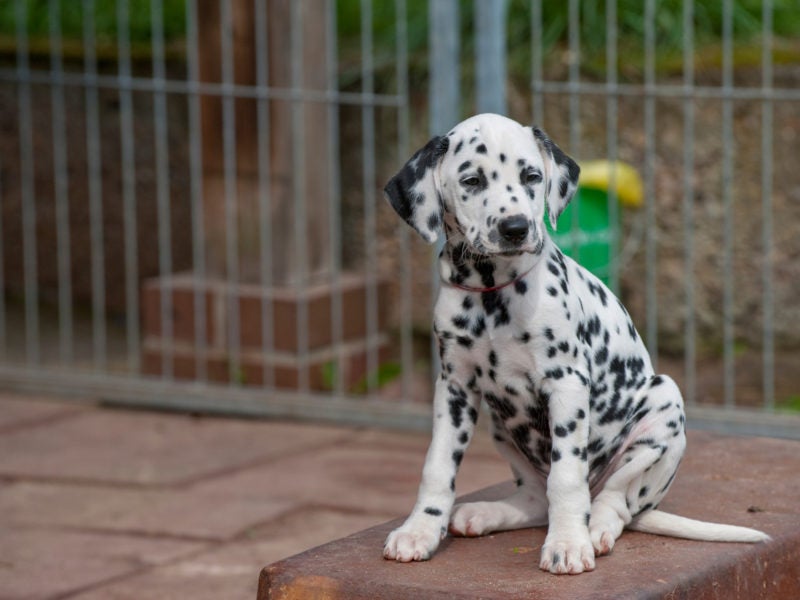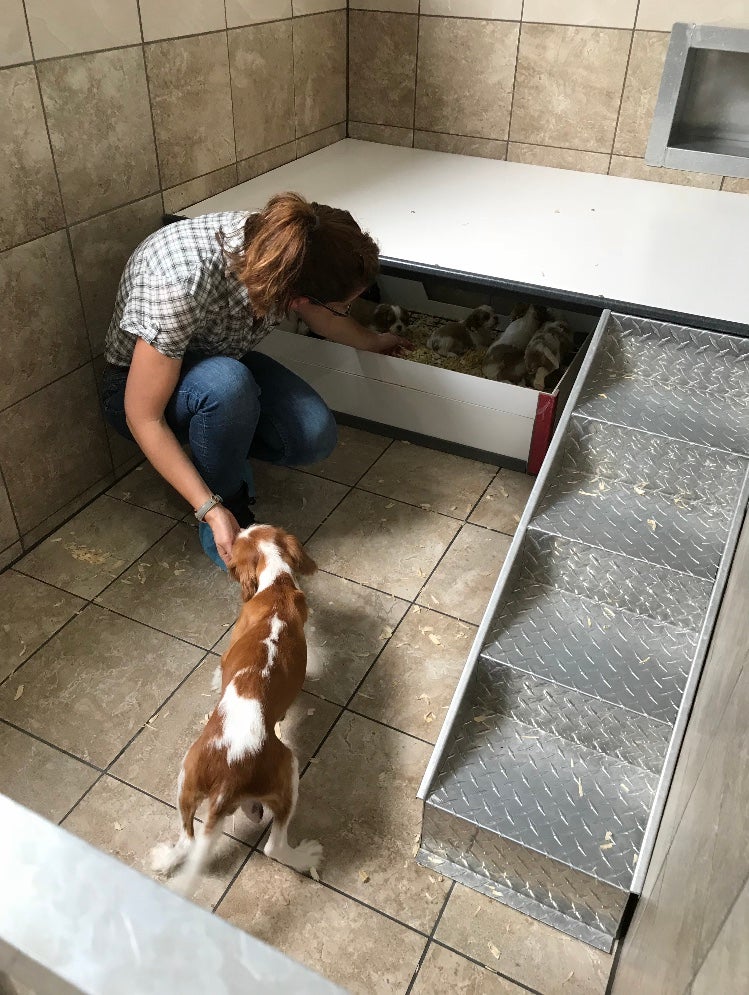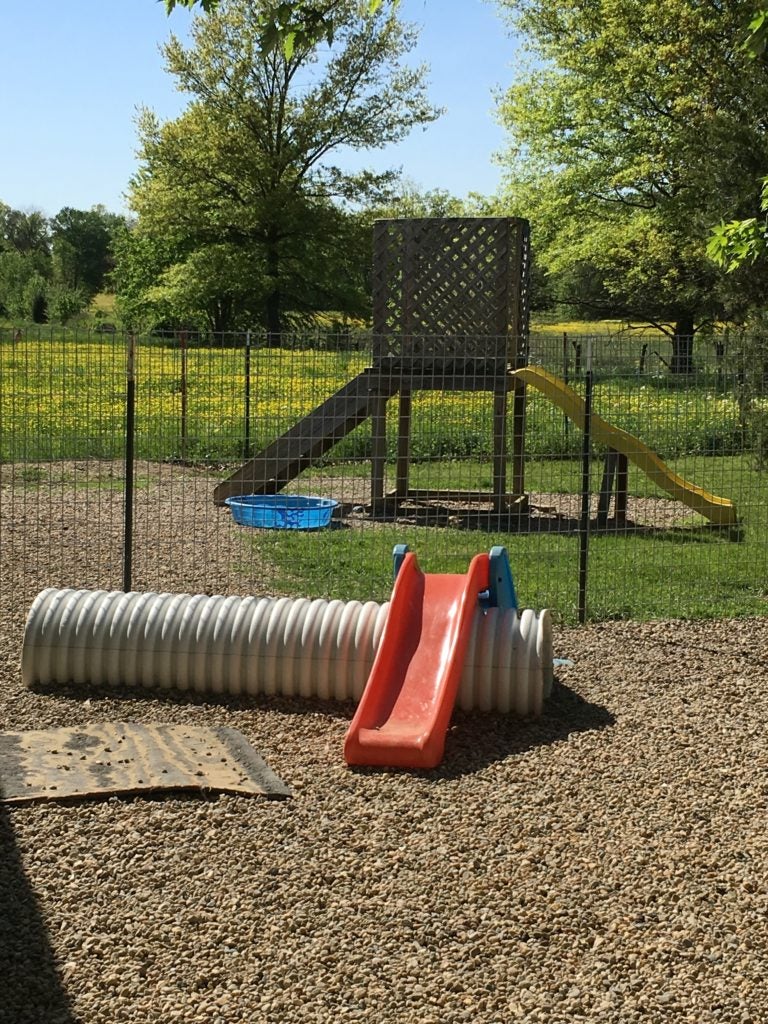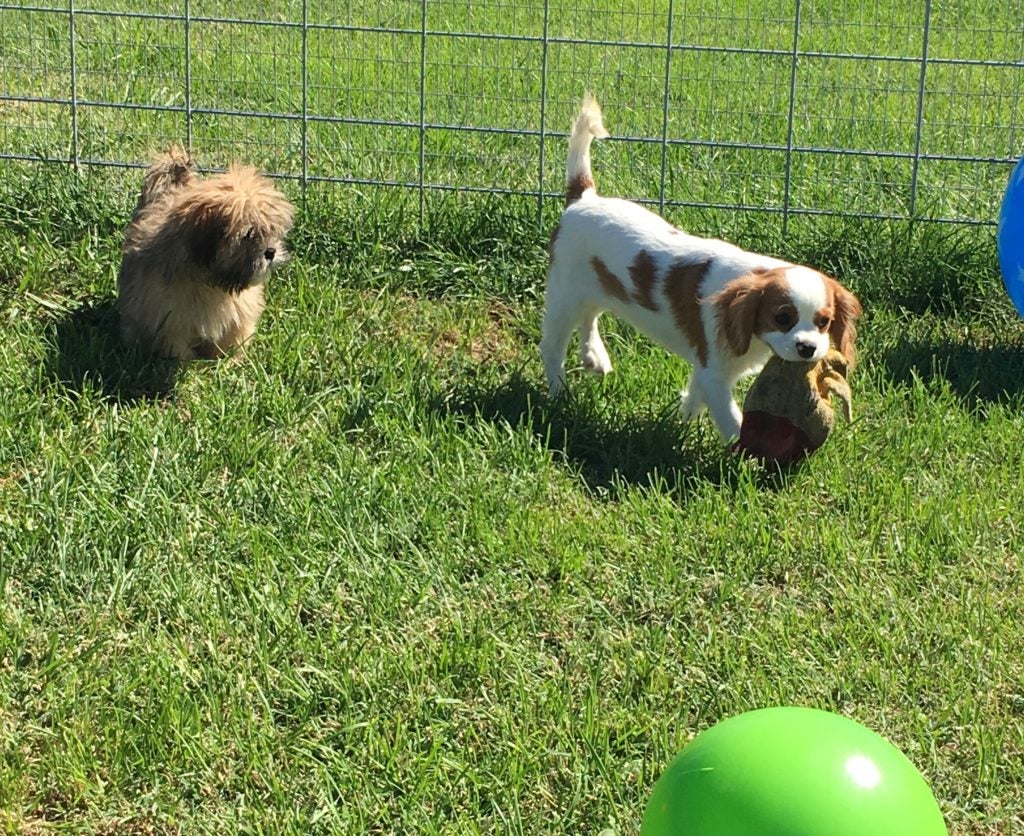
By Dr. Candace Croney, Ph.D., & Traci Shreyer, M.A.
The environment in which a dog or puppy is raised will have significant impacts on virtually every aspect of his or her life. The quality of the kennel environment can affect a dog’s physical health, comfort, and safety.
A kennel that is aesthetically pleasing to people but does not adequately meet the dogs’ needs is a poor investment of resources that can create or worsen unnecessary stress for dogs and their caretakers. For example, a beautiful kennel that is constructed primarily with materials that amplify noise can result in an environment that is damaging to dog and human hearing and one in which people want to spend as little time as possible. Reduced caretaker time in the kennel is a missed opportunity to observe the dogs, catch problems early, and spend time positively interacting with them.
The Influence of Kennel Design
An improperly designed kennel can also be costly, creating conditions that are conducive to dog and human illness or injury as well as those that are difficult for caretakers to manage or function ineffectively. A poorly ventilated kennel, for instance, can make it difficult to keep ammonia levels low, contributing to upper respiratory problems for dogs and puppies (as well as people) and can lead to increased disease transmission between the animals.
How a kennel is designed and what features it offers can also critically influence learning and behavior in dogs and puppies. This, in turn, impacts how well they do in their current and future environments. Ensuring that a kennel is designed to set dogs and puppies up for success both within and outside of that environment requires understanding that good animal welfare includes more than the basic food, water, and shelter needed for biological functioning. Finding ways to also meet the dog’s behavioral and psychological needs is essential.
All kennels should be built to meet applicable state and federal requirements. However, several additional factors should be considered when planning a new kennel or thinking about how to modify an existing facility:
- The breeds and sizes of the dogs to be housed and cared for
- The type of kennel to be constructed — indoor, outdoor or indoor/outdoor
- Special needs and uses (e.g., exam rooms, quarantine areas, whelping areas)
- Construction design and materials to ensure the physical safety of dogs, compliance with relevant state and federal requirements, and to optimize the usability of the space by both people and animals
- Accommodations for dog behavior that help to set dogs and puppies up for success while they live in the kennel and in their future homes
Discussing all these factors in-depth is not possible here. The concept of designing animal facilities to accommodate behavior is an emerging challenge for everyone who houses and manages animals and is particularly important for dogs, who are intended to produce or themselves serve as lifelong companions and “good citizens” in their homes and communities. For these reasons, we focus on key areas in which the behavioral needs and welfare of dogs can be incorporated into kennel design.

Noise Levels
The National Institute for Occupational Safety and Health has reported that sound levels in many kennels are dangerous to humans and could cause hearing loss in kennel workers as well as dogs and puppies. As dogs are more sensitive to sounds than humans, noise levels within kennels pose a serious health and welfare concern for both dogs and their caretakers. Consistently noisy kennel environments are common and unpleasant to dogs. This can lead to overstimulation and distress to dogs, which can result in behaviors that are unwanted and unproductive, such as repetitive barking. Unfortunately, most noise in kennels is caused by the dogs themselves. Reducing noise caused by the resident dogs can present a major challenge. To help with noise reduction and to create a healthier housing environment:
- Incorporate materials, such as sound reducing panels into the kennel design
- Muffle noise from gate and door hardware and open and close them gently
- Use visual blockers (e.g., solid-sided panels) on the sides of outdoor pens and lower halves of interior pen doors to minimize startling and distractions to dogs
- Reduce maternal stress by creating separate, low-traffic spaces apart from a noisy main kennel area; separate whelping rooms or areas that can be kept clean, dry, and warm enough to ensure comfort for both the bitch and her puppies are ideal
- These minimize stress by helping bitches feel secure and by reducing disruptions to them and their puppies; such spaces should be able to be easily monitored and maintained
- Consider caretaker traffic patterns — avoid designs that create main thoroughfares in front of the kennels
- Create spaces that allow for safe, convenient provision of activities such as exercise, social interaction with caretakers and other dogs, and environmental enrichment that promote behavioral wellness and decrease high arousal, frustration, and fear which fuel barking
Space & Exercise
The amount and quality of space a kennel provides are basic considerations in kennel design. Optimal kennel design considers what dogs and puppies should be able to do and how well the space provided allows this to occur. USDA size requirements for kenneled dogs are based on the estimated space a dog needs to “comfortably sit, stand, and lie in a normal manner and to turn about freely.”
While this is a common–sense approach to estimating kennel size requirements, there is not enough science yet to clearly quantify the best kennel size for dogs based on their needs and preferences. Nor is there enough science to determine how these may differ based on age, breed, size, gender, or physical status of the dog.
Addressing kennel size alone is not enough to properly address the needs of dogs and puppies. In addition to the amount of space provided, the number of dogs within the space along with the size of the dogs may impact how space is used. The quality of the space matters as much, if not more, than the amount of space allotted once minimum space requirements are met. Dogs prefer to eliminate away from the areas where they eat, drink, and sleep, and they perform fewer repetitive behaviors such as spinning, pacing, or wall bouncing when they are housed in social groups instead of by themselves. Providing environmental enrichment (e.g., toys) can encourage dogs to perform a wider variety of natural behaviors when they are held in larger enclosures. In addition, dogs should have the opportunity to access exercises spaces that are large enough to allow them to extend to full stride while running and playing, as these behaviors are important for their emotional and physical well-being.

The amount and quality of time the dog spends outside the kennel is also important. Whenever possible, kennels should be designed to allow dogs the opportunity to safely access the outdoors. Whether this is accomplished through the provision of an outdoor run connected to an interior primary enclosure or through providing dogs with a dedicated exercise area, access to fresh air, different flooring surfaces, and opportunities to move between spaces are beneficial for dogs’ physical and behavioral health.
For dogs that live permanently in kennels, access to different types of surfaces — including solid flooring — may help to protect their foot and leg health. For dogs and puppies intended to go into homes beyond the kennel, learning to move between and on different flooring surfaces is likely to help them adapt to those they will encounter in their new homes. In fact, simply providing the dogs a choice to move between their indoor and outdoor enclosures can help them to avoid or cope with stress. Access can be restricted to promote safety from predators, inclement weather or during whelping and other periods when movement restriction is necessary. Outdoor access options such as dog doors may help to promote airflow and air quality in the interior portion of the dogs’ enclosures and give caretakers flexibility to restrict outdoor access as needed to facilitate cleaning and to promote the health and safety of dogs.
Effective Space Use
Here are some tips for incorporating effective space use and outdoor access:
- Incorporate separate areas for nesting and elimination so that pups can practice being clean and prepare them for successful housetraining
- Include enough pen space in designs to accommodate social housing
- Consider the location of drains and layout design to facilitate ease in providing enrichment, and prevent problems when adding items such as toys and chews to the pen
- Create spaces for physical exercise and safe social contact/play within friendly dog groups; consider size, breed-specific behaviors, and individual dog preferences
- Designs that include indoor and outdoor options allow for variation and opportunities even in inclement weather
- Utilize gates and alleyways to promote efficiency and ease for handlers when moving dogs between the home pen and these areas
- Avoid creating high arousal and frustration by positioning exercise yards directly adjacent to dogs confined in home pens
Building in Enrichment
Environmental enrichment is the provision of accommodation or enhancement to the kennel that improves the quality of animal care in various ways. Effective enrichment can help to increase the number and types of normal behaviors dogs show, reduce abnormal behaviors, increase their use of the space given to them, and help them to cope with stress. In fact, a major way in which enrichment helps dogs to cope is by giving them the opportunity to have some control over aspects of their environment. Introducing enrichment into kennel design typically involves altering both the quality and complexity of the dog’s living space. Many breeders will be familiar with providing toys as one of the most common forms of enrichment for dogs and puppies.

Providing suitable, well-maintained beds can also be enriching as not only may these help to keep dogs and puppies comfortable and dry, they can provide an opportunity to hide or elevate as well as view the environment from a different perspective. Portable exercise pens or the addition of more permanent puppy playpens/yards built into safe areas of the kennel environment promote socialization of pups by exposing them to objects and surfaces outside their home pen. Remember — gentle exposure in many locations is critical for success.
Besides adding items to existing structures, the kennel itself can be designed to be more enriching to the dogs. This type of enrichment provides the additional benefit of improved socialization to common items, surfaces, and experiences found in household environments. These items not only better prepare pups for their new homes, but they also can be helpful in preparing retiring breeding dogs to transition successfully to new homes. Additionally, built-in “furnishings” create a scenario where dogs can experience these items “automatically” without the need for direct breeder interaction to produce the benefits.
Useful Kennel Design Enhancements
Any of the following can be useful design enhancements:
- Raised platforms that provide areas that allow dogs to rest and elevate themselves; these may be a safer alternative for dogs inclined to chew soft bedding
- Steps and ramps built into pen design to provide additional exercise as well as prepare dogs to navigate these common surfaces
- Multiple surfaces (e.g. grass, gravel, mats, cement, tile) that can be added to both home pen and exercise/play areas to create a complex environment; these can be particularly helpful in promoting successful housebreaking as puppies learn which surfaces to use for toileting during early developmental periods that occur before seven weeks of age and will often develop lifelong preferences for eliminating on these
- Outdoor yards or interior play areas outfitted with safe structures (e.g. slides, tunnels, children’s climbing structures) that enhance learning and exercise
- Safe options for expressing natural behaviors outdoors such as sandboxes for digging, shallow pools for swimming and temperature regulation, and opportunities to explore by sniffing
- Puppy housing that allows for easy introduction of objects and novel surfaces
- Space and tools that promote caretaker ease in the management of enrichment items such as storage/preparation areas and sinks/dishwashers/washing machines to aid in clean up
- Opportunities for dogs to either see or hide from people/dogs/objects outside the home pen: reduce frustration and fear by incorporating both solid barriers and those that allow visual access and providing additional pen furnishings that allow for perching or hiding
- Front pen design that allows for easy comfortable contact between caretaker and dogs. Avoid systems that force handlers to lean in over dogs to visualize, interact, or perform daily husbandry activities. This position limits caretaker ability to monitor dogs, can be threatening to sensitive dogs, and can cause injury to caretakers themselves over time
Outdoor Kennel Design Considerations
The decision to maintain dogs in kennels that are primarily outdoors should consider numerous factors. These include the suitability of the breed for the environmental conditions they are likely to face and the ability to safely contain dogs and protect them from inclement weather and predators. These kinds of kennels should ensure that dogs have sheltered or covered areas that are large enough and well distributed so that dogs do not have to compete for access to them. Such areas should be well drained, so dogs are not forced to lie in damp areas to access shade or shelter from the elements. Special attention must also be paid to ensuring that dogs have enough other resources needed to keep themselves as cool or warm as needed. These can include outdoor houses, windbreaks provided through man-made structures or landscaping, misters, heat lamps, and heating/cooling elements or devices that are safe for dogs and easy to maintain.
Take Home Messages
The best kennel design for a breeder is the one that works best for his or her dogs and puppies. Not only should a kennel provide the animals a safe, sturdy, clean shelter that meets their physical needs, designing kennels to better meet the behavioral needs of the dogs they house will ensure that they ultimately offer the best return on investment in dog care and well-being.
Dr. Candace Croney, Ph.D. is the director of the Purdue University Center for Animal Welfare Science and a Professor of Animal Behavior and Well-Being. Traci Shreyer, M.A. is a Purdue University Breeding Dog Welfare Research Associate.

